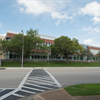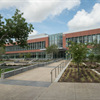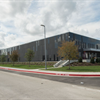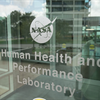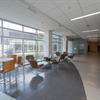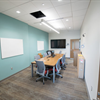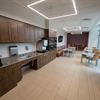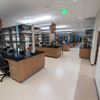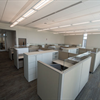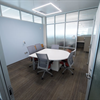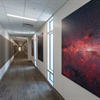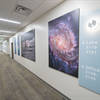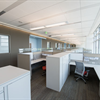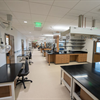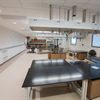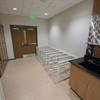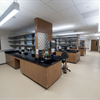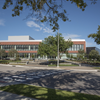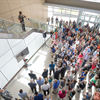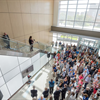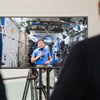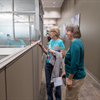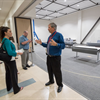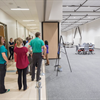New building reaffirms Johnson’s commitment to biomedical research and sustainability
2017-07-27
On July 26, NASA’s Johnson Space Center unveiled Building 21, the newly minted home of the Human Health and Performance Laboratory. Wielding oversized scissors, Johnson Director Ellen Ochoa officially cut the ribbon in the entryway, ushering in the next chapter of biomedical research in support of human space exploration.
Though the new facility is architecturally stunning, there’s a lot of function packed into its decorative and sustainable touches—some of which are a nod to the serious science that will be performed within its walls.
“Two architectural-ish things I like? The north-side wall is covered in contrasting black glossy and flat black stone, designed to mimic a DNA sequence,” said Joel Walker, Johnson’s director of Center Operations. “The crosswalk from Building 45 to Building 21 also contains a DNA artistic representation in keeping with the theme of the building.”
Expedition 52 Flight Director Peggy Whitson sends down her congratulations for the new building from the International Space Station. Image Credit: NASA
Building 21 is a structural embodiment of JSC 2.017 and the center’s efforts to lead by being lean, agile and adaptive to change. This facility boasts a flexible, reconfigurable layout to better acclimate to changing mission needs and requirements. The plethora of meeting spaces adjacent to laboratories allows researchers to optimize utilization, reduce silos and interact more in person. With shared resources in support of multiple programs and partners, the building is the perfect specimen of what’s in store for the future: a collaborative concept of operations.
“On behalf of the Johnson Space Center, we are thrilled the agency has made such a significant investment in the future of human space exploration with this new Human Health and Performance Laboratory, Building 21,” said Judith Hayes, chief of the Biomedical Research and Environmental Sciences Division within the Human Health and Performance Directorate. “This is the heart of NASA’s biomedical research and operations for human spaceflight, and where innovations will originate to address important astronaut health risks resulting from exploration beyond low-Earth orbit. It is here where our extraordinary scientists will further our understanding of space physiology, behavioral health and space vehicle environments in support of astronaut health, safety and performance.”
Johnson’s Human Health and Performance team is excited to move in and has already made its literal mark on the facility. Building 21 has a support beam installed in the high-bay ceiling that was signed by the laboratory and administrative workers who will soon call it home.
The facility is expected to garner a Leadership in Energy and Environmental Design silver rating—just another example of the center leading the way in sustainable architecture that is kinder to planet Earth. Some “cool” features include solar shading devices that optimally orient to provide daylight with minimum glare to the workers within. Building stairwells are not dark, dank and dreary affairs befitting of a horror flick; they instead have quality finishes, natural daylighting and views that encourage healthy stair use. A significant percentage of the materials used in Building 21’s construction was also chosen for its highly recycled content and regional proximity.
But for all this talk of green fixtures and silver ratings, the real color Johnson and these Human Health and Performance employees are focused on happens to be red—or maybe orange, depending on your opinion about the Martian surface.
“At NASA, we are embarking on perhaps the greatest journey ever attempted,” Hayes said. “The critical path for humans going to Mars will pass through this facility, where our multidisciplinary science teams will enable astronauts to pioneer that next giant leap in exploration.”
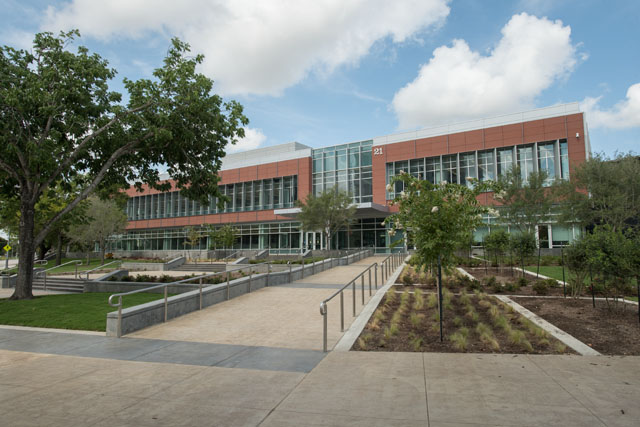
The new Human Health and Performance Laboratory, Building 21, will enable the next steps of human space exploration through cutting-edge biomedical research. Image Credit: NASA/Robert Markowitz and Josh Valcarcel
Human Health and Performance Laboratory—by the numbers
Enjoy more photos from the ribbon cutting and open house below.
Catherine Ragin Williams
NASA Johnson Space Center
Though the new facility is architecturally stunning, there’s a lot of function packed into its decorative and sustainable touches—some of which are a nod to the serious science that will be performed within its walls.
“Two architectural-ish things I like? The north-side wall is covered in contrasting black glossy and flat black stone, designed to mimic a DNA sequence,” said Joel Walker, Johnson’s director of Center Operations. “The crosswalk from Building 45 to Building 21 also contains a DNA artistic representation in keeping with the theme of the building.”
Expedition 52 Flight Director Peggy Whitson sends down her congratulations for the new building from the International Space Station. Image Credit: NASA
Building 21 is a structural embodiment of JSC 2.017 and the center’s efforts to lead by being lean, agile and adaptive to change. This facility boasts a flexible, reconfigurable layout to better acclimate to changing mission needs and requirements. The plethora of meeting spaces adjacent to laboratories allows researchers to optimize utilization, reduce silos and interact more in person. With shared resources in support of multiple programs and partners, the building is the perfect specimen of what’s in store for the future: a collaborative concept of operations.
“On behalf of the Johnson Space Center, we are thrilled the agency has made such a significant investment in the future of human space exploration with this new Human Health and Performance Laboratory, Building 21,” said Judith Hayes, chief of the Biomedical Research and Environmental Sciences Division within the Human Health and Performance Directorate. “This is the heart of NASA’s biomedical research and operations for human spaceflight, and where innovations will originate to address important astronaut health risks resulting from exploration beyond low-Earth orbit. It is here where our extraordinary scientists will further our understanding of space physiology, behavioral health and space vehicle environments in support of astronaut health, safety and performance.”
Johnson’s Human Health and Performance team is excited to move in and has already made its literal mark on the facility. Building 21 has a support beam installed in the high-bay ceiling that was signed by the laboratory and administrative workers who will soon call it home.
The facility is expected to garner a Leadership in Energy and Environmental Design silver rating—just another example of the center leading the way in sustainable architecture that is kinder to planet Earth. Some “cool” features include solar shading devices that optimally orient to provide daylight with minimum glare to the workers within. Building stairwells are not dark, dank and dreary affairs befitting of a horror flick; they instead have quality finishes, natural daylighting and views that encourage healthy stair use. A significant percentage of the materials used in Building 21’s construction was also chosen for its highly recycled content and regional proximity.
But for all this talk of green fixtures and silver ratings, the real color Johnson and these Human Health and Performance employees are focused on happens to be red—or maybe orange, depending on your opinion about the Martian surface.
“At NASA, we are embarking on perhaps the greatest journey ever attempted,” Hayes said. “The critical path for humans going to Mars will pass through this facility, where our multidisciplinary science teams will enable astronauts to pioneer that next giant leap in exploration.”

The new Human Health and Performance Laboratory, Building 21, will enable the next steps of human space exploration through cutting-edge biomedical research. Image Credit: NASA/Robert Markowitz and Josh Valcarcel
Human Health and Performance Laboratory—by the numbers
- 118,000 square feet
- Houses 17 laboratories, 44 offices, 250 open workstations, eight huddle rooms, four conference rooms, three break rooms and one landscaped courtyard
- Incorporates multiple shared assets such as the Core Lab, an 8,000-square-foot high bay and microscopy and tissue culture rooms
- Showcases 57 pieces of art reflecting the history of human spaceflight, Johnson’s current portfolio of work and NASA’s future goals
- Contains 2,000 Information Technology connections, with 1,200 activated already for occupancy
- Decluttering efforts prior to the move-in resulted in approximately 2,000 items being moved to Building 21 and roughly 2,500 identified for excess
Enjoy more photos from the ribbon cutting and open house below.
Catherine Ragin Williams
NASA Johnson Space Center








